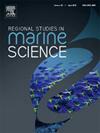气候变化背景下强烈厄尔尼诺/南方涛动+对巴伊亚马格达莱纳(墨西哥下加利福尼亚西南部)影响的差异
IF 2.4
4区 环境科学与生态学
Q3 ECOLOGY
引用次数: 0
摘要
马格达莱纳湾-阿尔梅哈斯湾(BM-BA)综合体是墨西哥太平洋最大的沿海泻湖系统;它位于温带和热带地区之间的过渡地带。BM-BA 具有高度的生物多样性,是重要的渔业资源来源;然而,在 ENSO+ 事件期间,其生产力会下降。这项工作旨在比较全球变暖背景下三次最强烈的厄尔尼诺/南方涛动(1982-1983 年、1997-1998 年和 2015-2016 年)对其环境和生物特征的影响。自 1970 年以来,该地区一直在变暖,叶绿素-a 也在减少;然而,与流域尺度过程相关的短期环境变化改变了这些趋势。对比结果显示,赤道对 1997-1998 年厄尔尼诺/南方涛动的影响更为明显,而北太平洋条件和其他大尺度环境过程则影响了其他厄尔尼诺/南方涛动:1982-1983 年,暖信号在厄尔尼诺/南方涛动+结束后继续存在,而 2015-2016 年,由于 MWH The Blob 以及可能的全球变暖,暖信号在厄尔尼诺/南方涛动+开始前就已存在。海盆尺度的高温改变了大尺度风的模式,削弱了当地的上升流,减少了营养物质的输入。赤道和北太平洋对 BM 的影响随着时间的推移而变化(这在 BM 这样的过渡区是预料之中的);然而,近年来,与气候变化相关的北太平洋变暖可能变得越来越重要,并调节了 ENSO+ 的影响。本文章由计算机程序翻译,如有差异,请以英文原文为准。
Differences in the impact of intense ENSO+ in Bahia Magdalena (SW of Baja California, Mexico) in the context of climate change
The Bahia Magdalena-Bahia Almejas (BM-BA) complex is the largest coastal lagoon system in the Mexican Pacific; it is in a transitional zone between temperate and tropical regions. BM-BA has a high biodiversity and is an important source of fishing resources; however, its productivity diminishes during ENSO+ events. This work aimed to compare the impact of the three most intense ENSOs (1982–1983, 1997–1998, and 2015–2016) on their environmental and biological characteristics in the context of global warming. Since 1970, this region has been warming, and the chlorophyll-a is diminishing; however, short-term environmental variations associated with basin-scale processes have modified these trends. The comparison showed that the equatorial influence on the 1997–1998 ENSO was more evident, while the North Pacific conditions and other large-scale environmental processes influenced the other ENSOs: in 1982–1983, the warm signal continued after the ENSO+ ended, and in 2015–2016, it was present before the ENSO+ onset due to the MWH The Blob and probably global warming. High temperatures at the basin scale altered large-scale wind patterns, weakening local upwelling and diminishing the nutrient input. The Equatorial and North Pacific influence on BM varies over time (as expected in a transition zone like BM); however, in recent years, North Pacific warming associated with climate change has probably gained relevance and modulated the effect of ENSO+.
求助全文
通过发布文献求助,成功后即可免费获取论文全文。
去求助
来源期刊

Regional Studies in Marine Science
Agricultural and Biological Sciences-Ecology, Evolution, Behavior and Systematics
CiteScore
3.90
自引率
4.80%
发文量
336
审稿时长
69 days
期刊介绍:
REGIONAL STUDIES IN MARINE SCIENCE will publish scientifically sound papers on regional aspects of maritime and marine resources in estuaries, coastal zones, continental shelf, the seas and oceans.
 求助内容:
求助内容: 应助结果提醒方式:
应助结果提醒方式:


